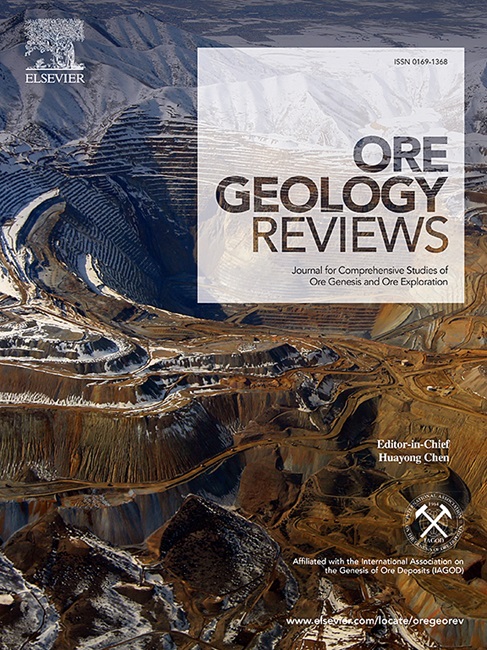华南江南造山带兴凤山矿床的地质和地球同步学:对与侵入有关的金-钨矿化的影响
IF 3.2
2区 地球科学
Q1 GEOLOGY
引用次数: 0
摘要
杏凤山是位于中国南方江南造山带中部的板岩型金-金矿床。该矿床由层状矽卡岩和片状石英脉组成,两类矿化物均具有W和Au金属关联。本研究通过系统的地质调查,结合 TESCAN 集成矿物分析仪(TIMA)和生物岩 40Ar/39Ar 分析,确定了地质特征和成矿时代。矽卡岩阶段(阶段 1)的形成由三个子阶段代表:(I)顺行矽卡岩、(II)逆行矽卡岩和(III)石英硫化物。白钨矿和少量原生金分别形成于第二和第三子阶段。TIMA结果证实了石榴石、辉石、阳起石、黑云母等矽卡岩矿物与白钨矿的共存。横切矽卡岩的片状金-W石英脉(第二阶段)含有含金砷黄铁矿、白钨矿、黄铁矿、石英,并显示出金(砷黄铁矿)、W(白钨矿)和黑云母的共存。矿石贫化后的石英脉(第三阶段)主要由石英、黝帘石和电气石组成。逆生矽卡岩和片状矿脉中的生物黄铁矿的 40Ar/39Ar 测定结果表明,其形成年龄分别为 215.0 ± 1.7 Ma 和 211.9 ± 1.7 至 209.8 ± 2.1 Ma。这些年龄与周围的花岗岩侵入体(218.7 ± 1.5 至 204.5 ± 2.8 Ma)大致同时。造成金-钨矿化的矿化流体很可能来自岩浆。考虑到江南造山带中部广泛存在的晚三叠世岩浆活动与金-钨矿化的时空关联,可以为杏峰山金-钨矿床的成因建立一个与侵入有关的金系统。本文章由计算机程序翻译,如有差异,请以英文原文为准。

Geology and geochronology of the Xingfengshan deposit, Jiangnan orogenic belt, South China: Implication for intrusion-related Au–W mineralization
The Xingfengshan is a slate-hosted Au–W deposit in the central part of the Jiangnan orogenic belt, South China. It comprises stratiform skarns and sheeted quartz veins, and both two types of mineralization have W and Au metal association. In this study, systematic geological investigation, together with TESCAN Integrated Mineral Analyzer (TIMA), and biotite 40Ar/39Ar analyses were performed to determine the geological features and mineralization age. Formation of skarn stage (Stage 1) is represented by three substages: (I) prograde skarn, (II) retrograde skarn, and (III) quartz–sulfide. Scheelite and minor native gold formed during substage II and III, respectively. TIMA results confirm the coexistence of skarn minerals such as garnet, pyroxene, actinolite, and biotite, and scheelite. Sheeted Au–W quartz veins (Stage 2) crosscutting skarns contain auriferous arsenopyrite, scheelite, pyrrhotite, quartz, and display coexistence of Au (arsenopyrite), W (scheelite), and biotite. Post-ore barren quartz veins (Stage 3) are mainly composed of quartz, muscovite and tourmaline. 40Ar/39Ar dating results of biotite from retrograde skarn and sheeted veins constraining the formation ages are 215.0 ± 1.7 Ma and 211.9 ± 1.7 to 209.8 ± 2.1 Ma, respectively. These ages are broadly contemporaneous with the surrounding granitoid intrusion (218.7 ± 1.5 to 204.5 ± 2.8 Ma). It is likely that mineralizing fluids responsible for Au–W mineralization are of magmatic in origin. Considering the temporal and spatial association of the widespread Late Triassic magmatism and Au–W mineralization in the central Jiangnan orogenic belt, an intrusion-related Au system could be established for genesis of the Xingfengshan Au–W deposit.
求助全文
通过发布文献求助,成功后即可免费获取论文全文。
去求助
来源期刊

Ore Geology Reviews
地学-地质学
CiteScore
6.50
自引率
27.30%
发文量
546
审稿时长
22.9 weeks
期刊介绍:
Ore Geology Reviews aims to familiarize all earth scientists with recent advances in a number of interconnected disciplines related to the study of, and search for, ore deposits. The reviews range from brief to longer contributions, but the journal preferentially publishes manuscripts that fill the niche between the commonly shorter journal articles and the comprehensive book coverages, and thus has a special appeal to many authors and readers.
 求助内容:
求助内容: 应助结果提醒方式:
应助结果提醒方式:


